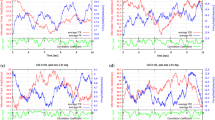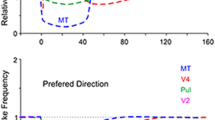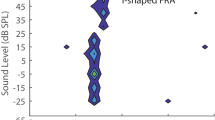Summary
The spike trains of X and Y retinal ganglion cell axons and neurons in the lateral geniculate nucleus (LGN) of cats were compared to determine if the visual signal could be better discriminated from the maintained activity in the LGN relative to the retina. Curves for relative or receiver operating characteristics (ROC) were derived from the interspike interval data of the spike trains using maintained activity as “noise” and visually-driven activity as the “signal”. Analyses were also made using spike densities and more restricted time intervals. Although it was expected that neurons in the LGN might better distinguish the signal from the noise, the results of the ROC curve and spike density analyses did not bear out this expectation; that is, neither the X or Y cells in the LGN provided better discrimination of the visually-driven activities from the maintained activities compared to the incoming retinal information. Thus, at least in the anesthetized preparation, the LGN does not play a role in increasing the signal-to-noise ratio.
Similar content being viewed by others
References
Barlow HB, Levick WR (1969) Three factors limiting the reliable detection of light by retinal ganglion cells of the cat. J Physiol 200: 1–24
Bullier J, Norton TT (1979a) X and Y relay cells in cat lateral geniculate nucleus: quantitative analysis of receptive-field properties and classification. J Neurophysiol 42: 244–273
Bullier J, Norton TT (1979b) Comparison of receptive-field properties of X and Y ganglion cells with X and Y lateral geniculate cells in the cat. J Neurophysiol 42: 274–291
Coenen AML, Vendrik AJH (1972) Determination of the transfer ratio of cat's geniculate neurons through quasi-intracellular recordings and the relation with the level of alertness. Exp Brain Res 14: 227–242
Cohn TE, Green DG, Tanner WP (1975) Receiver operating characteristic analysis: application to the study of quantum fluctuation effects in optic nerve of Rana pipiens. J Gen Physiol 66: 583–616
Cleland BG, Lee BB (1985) A comparison of visual responses of cat lateral geniculate neurones with those of ganglion cells afferent to them. J Physiol 369: 249–268
Fukuda Y, Stone J (1976) Evidence of differential inhibitory influences on X- and Y-type relay cells in the cat's lateral geniculate nucleus. Brain Res 113: 188–196
Gage PW, Robertson B (1985) Prolongation of inhibitory postsynaptic currents by pentobarbitone, halothane and ketamine in CA1 pyramidal cells in rat hippocampus. Br J Pharmacol 85: 675–681
Green DM, Swets JA (1966) Signal detection theory and psychophysics. Wiley, New York
Hirsch JC, Fourment A, Marc ME (1983) Sleep-related variations of membrane potential in the lateral geniculate body relay neurons of the cat. Brain Res 259: 308–312
Hubel DH (1960) Single unit activity in lateral geniculate body and optic tract of unrestrained cats. J Physiol 150: 91–104
Levick WR, Thibos LN, Cohn TE, Catanzaro D, Barlow HB (1983) Performance of cat retinal ganglion cells at low light levels. J Gen Physiol 82: 405–426
Levine MW, Troy JB (1986) The variability of the maintained discharge of cat dorsal lateral geniculate cells. J Physiol 375: 337–359
Livingstone MS, Hubel DH (1981) Effects of sleep and arousal in the processing of visual information in the cat. Nature 291: 554–561
McCarley RW, Benoit O, Barrionuevo G (1983) Lateral geniculate nucleus unitary discharge in sleep and waking: state- and rate-specific aspects. J Neurophysiol 50: 798–818
Moore GP, Perkel DH, Segundo JP (1966) Statistical analysis and functional interpretation of neuronal spike data. Ann Rev Physiol 28: 493–522
Perkel DH, Bullock TH (1969) Neural coding. In: Schmitt FO (ed) Neurosci. Res Symp Summ
Rapisardi SC, Miles RP (1981) Synaptology of retinal terminals in the dorsal lateral geniculate nucleus of the cat. J Comp Neurol 223: 515–534
Pollack I, Hsieh R (1969) Sampling variability of the area under the ROC-curve and of d'. Psycholog Bull 71: 161–173
Rodieck RW (1967) Maintained activity of cat retinal ganglion cells. J Neurophysiol 30: 1043–1071
Singer W, Bedworth N (1973) Inhibitory interaction between X and Y units in the cat lateral geniculate nucleus. Brain Res 49: 291–307
Swets JA (1973) The relative operating characteristic in psychology. Science 182: 990–1000
Tolhurst DJ, Movshon JA, Dean AF (1983) The statistical reliability of signals in single neurons in cat and monkey visual cortex. Vision Res 23: 775–785
Wilson JR, Friedlander MF, Sherman SM (1984) Fine structural morphology of identified X- and Y-cells in the cat's lateral geniculate nucleus. Proc R Soc Lond 221: 411–436
Author information
Authors and Affiliations
Rights and permissions
About this article
Cite this article
Wilson, J.R., Bullier, J. & Norton, T.T. Signal-to-noise comparisons for X and Y cells in the retina and lateral geniculate nucleus of the cat. Exp Brain Res 70, 399–405 (1988). https://doi.org/10.1007/BF00248364
Received:
Accepted:
Issue Date:
DOI: https://doi.org/10.1007/BF00248364




